Charles E W Bean, Diaries, AWM38 3DRL 606/254/1 - 1917 - 1933 - Part 11
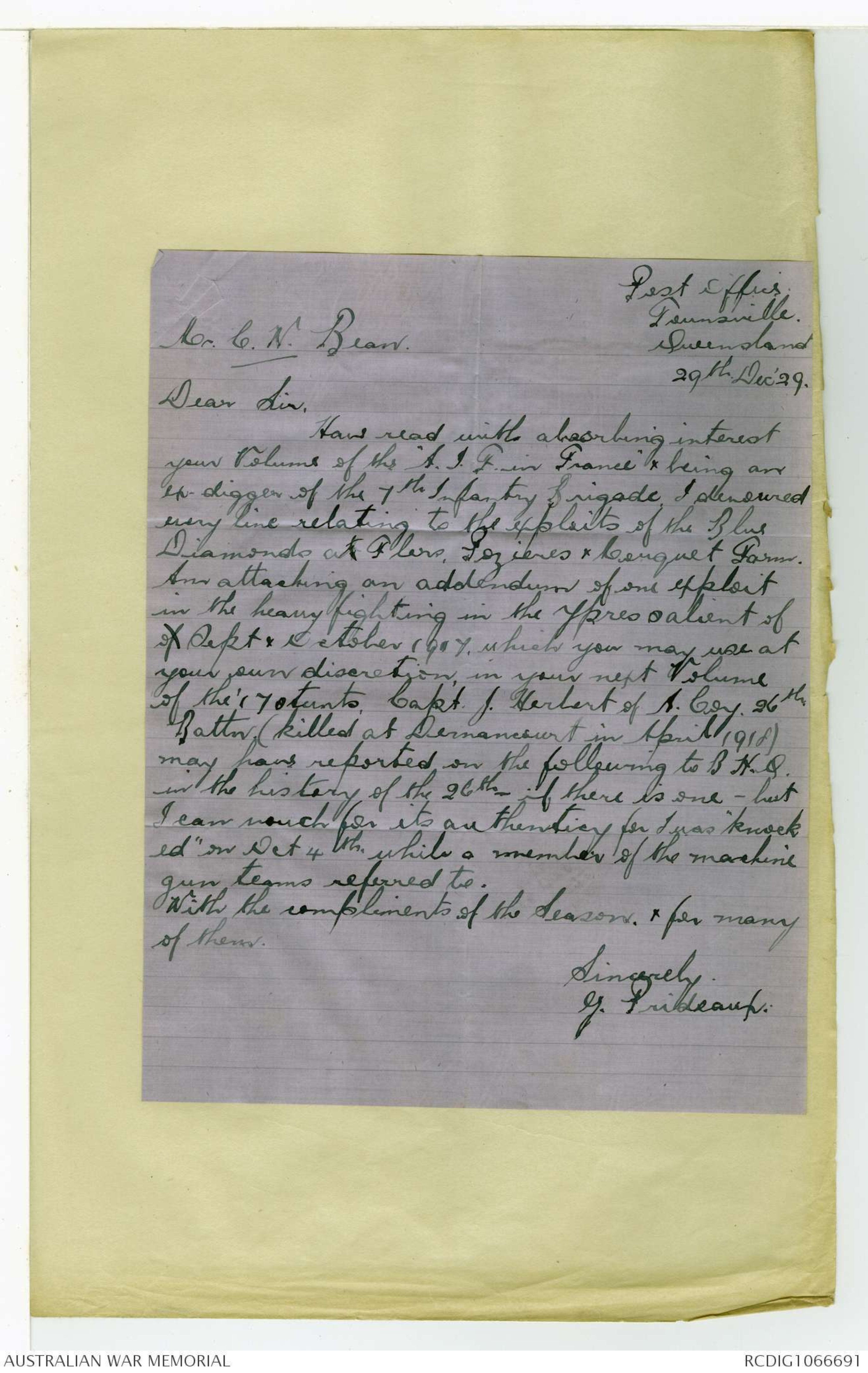
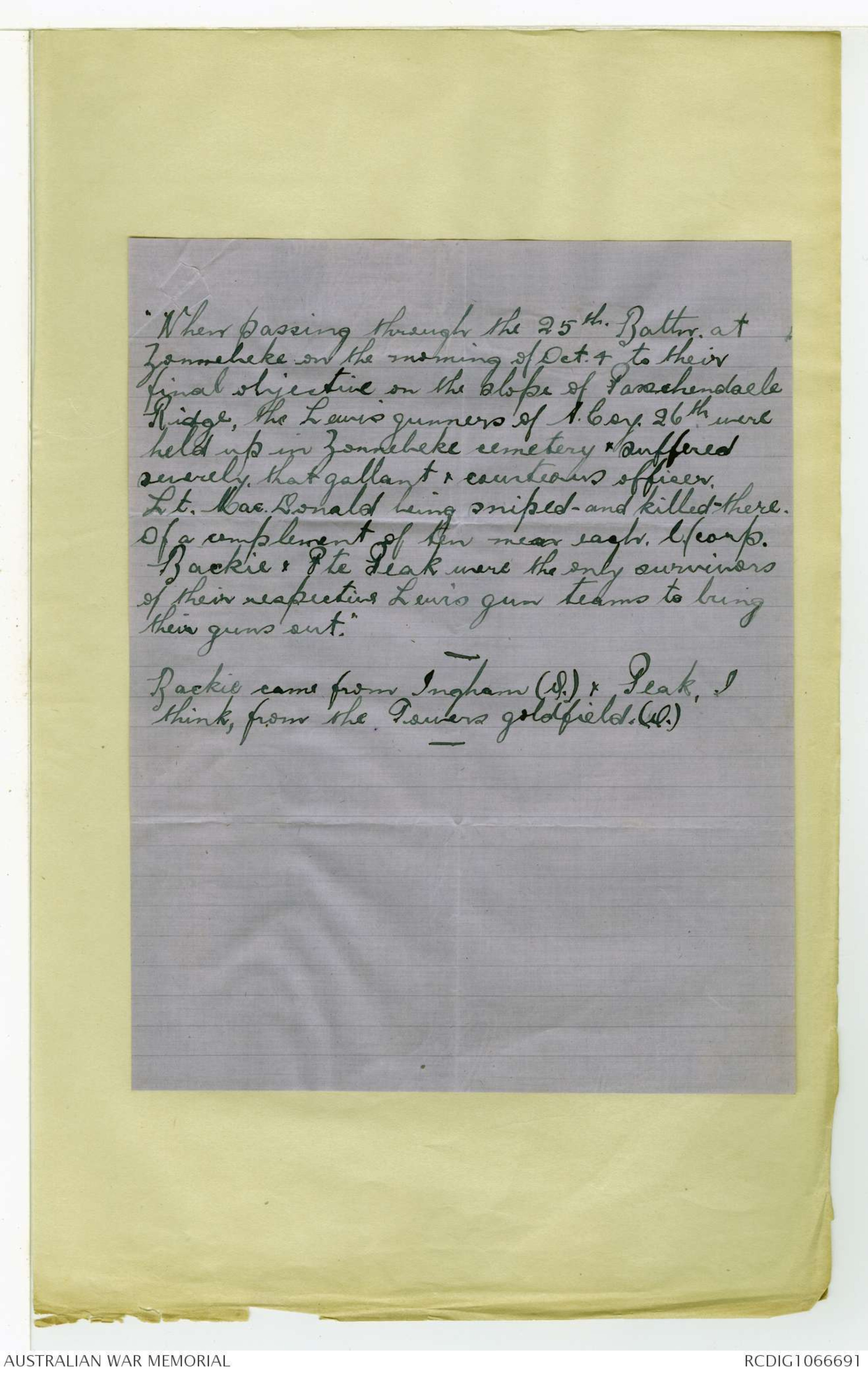
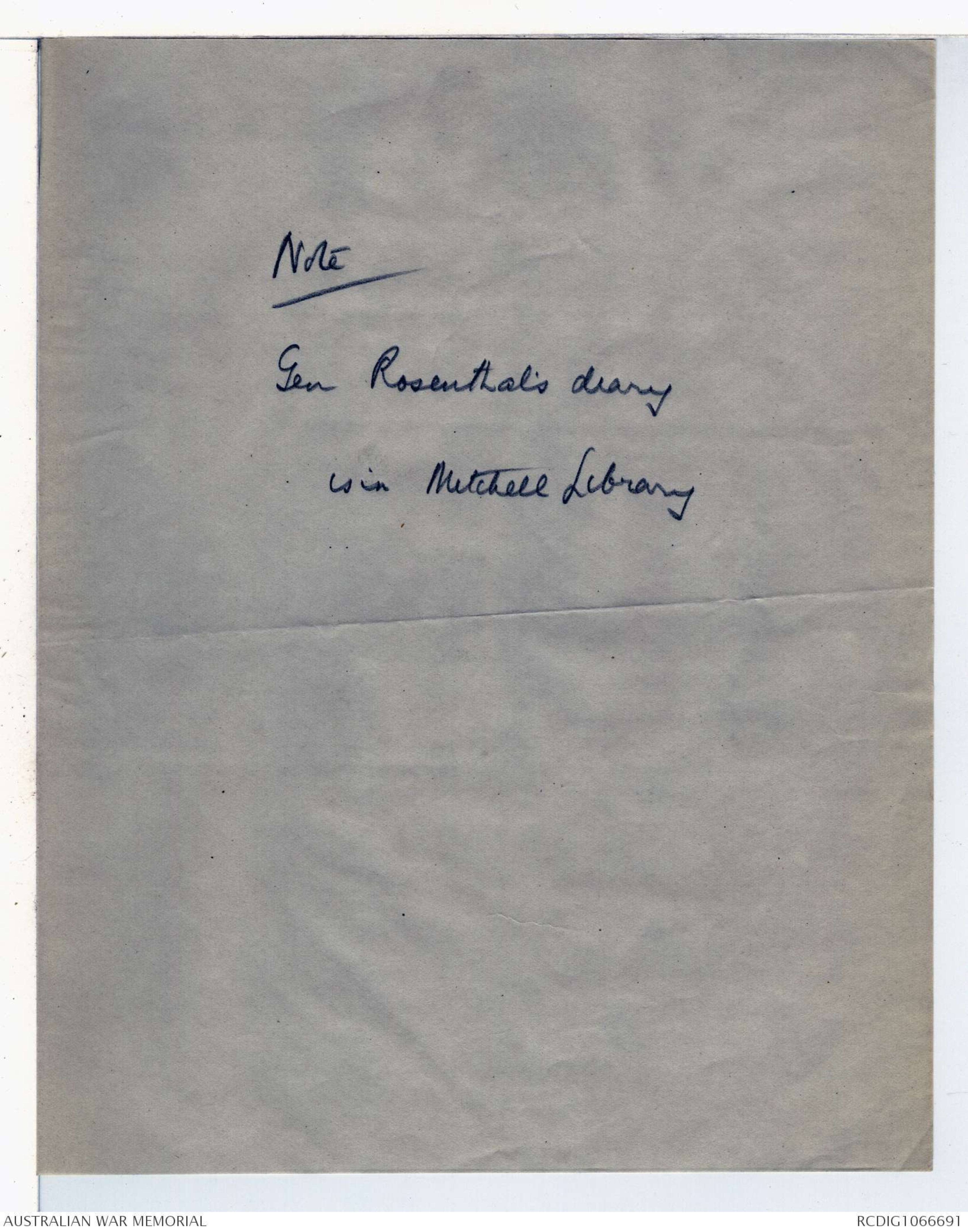

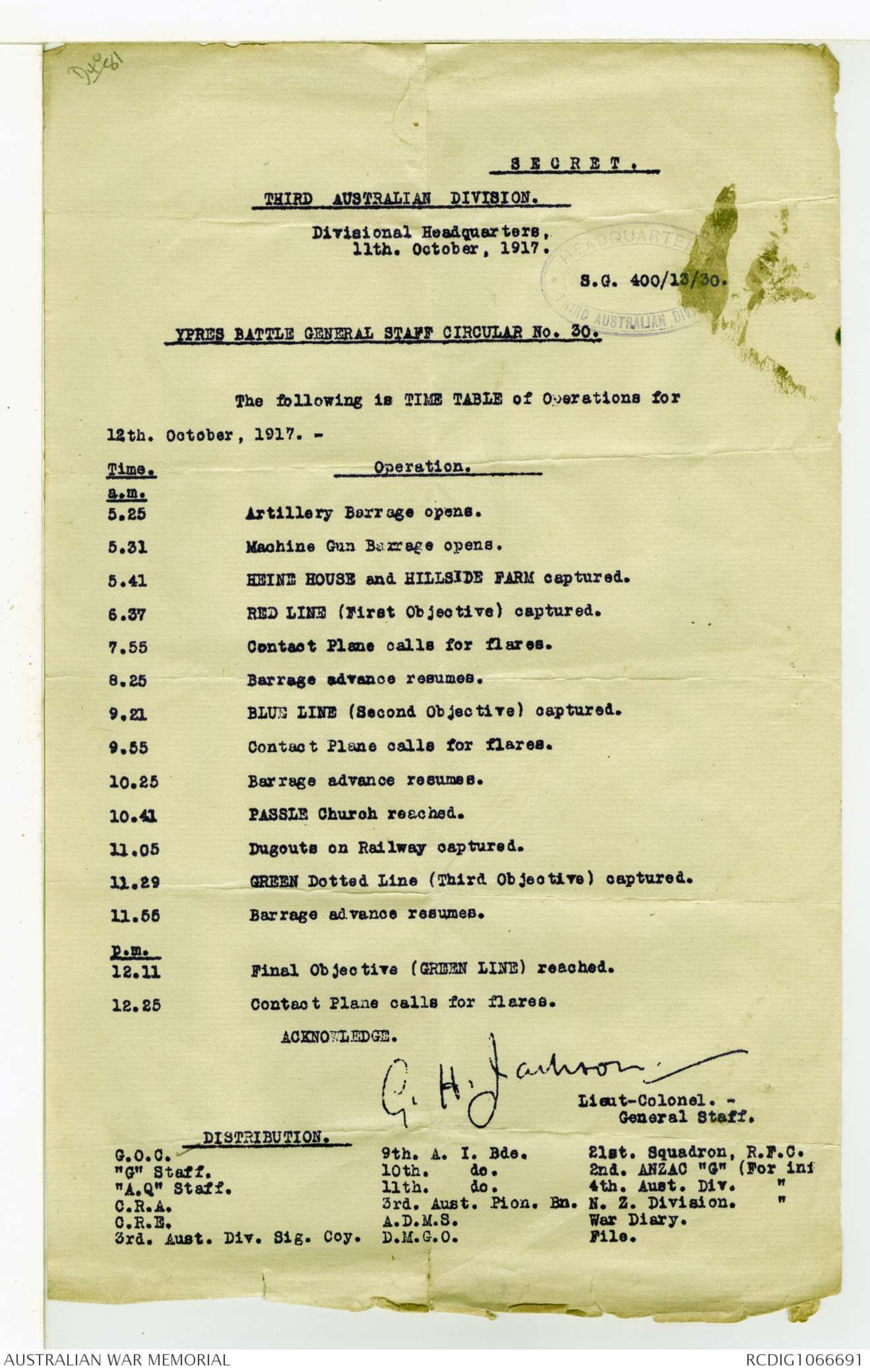
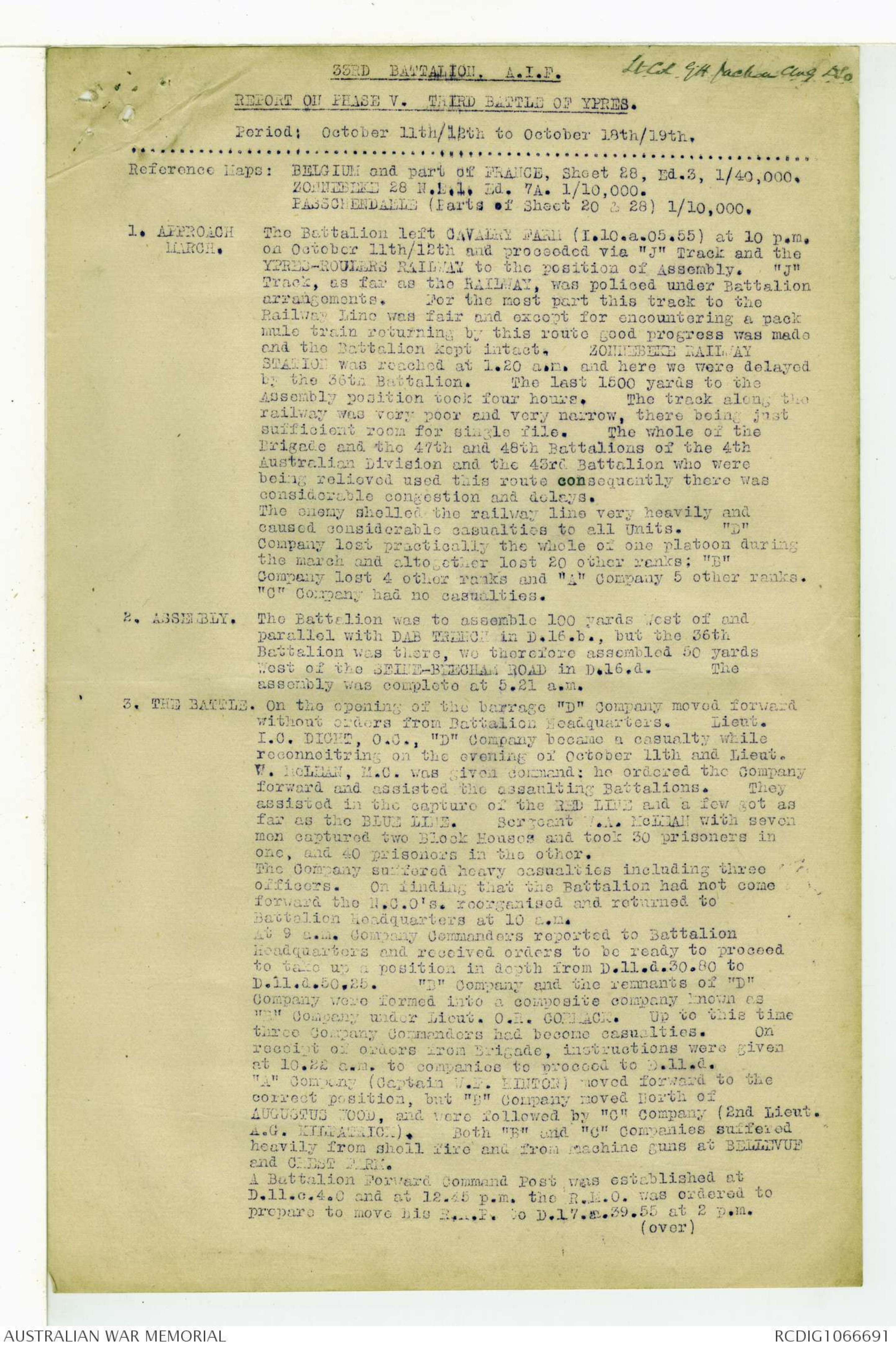
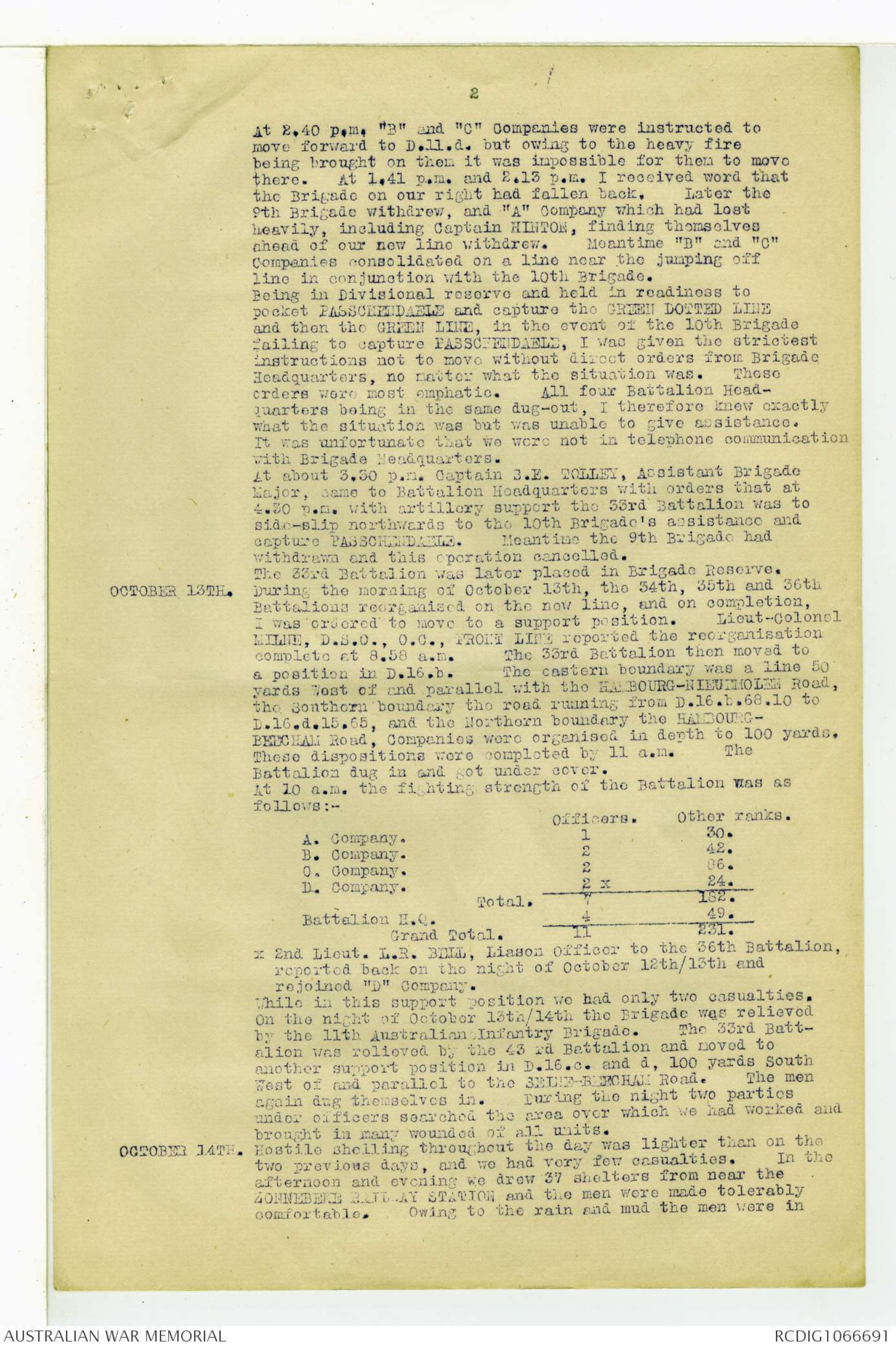
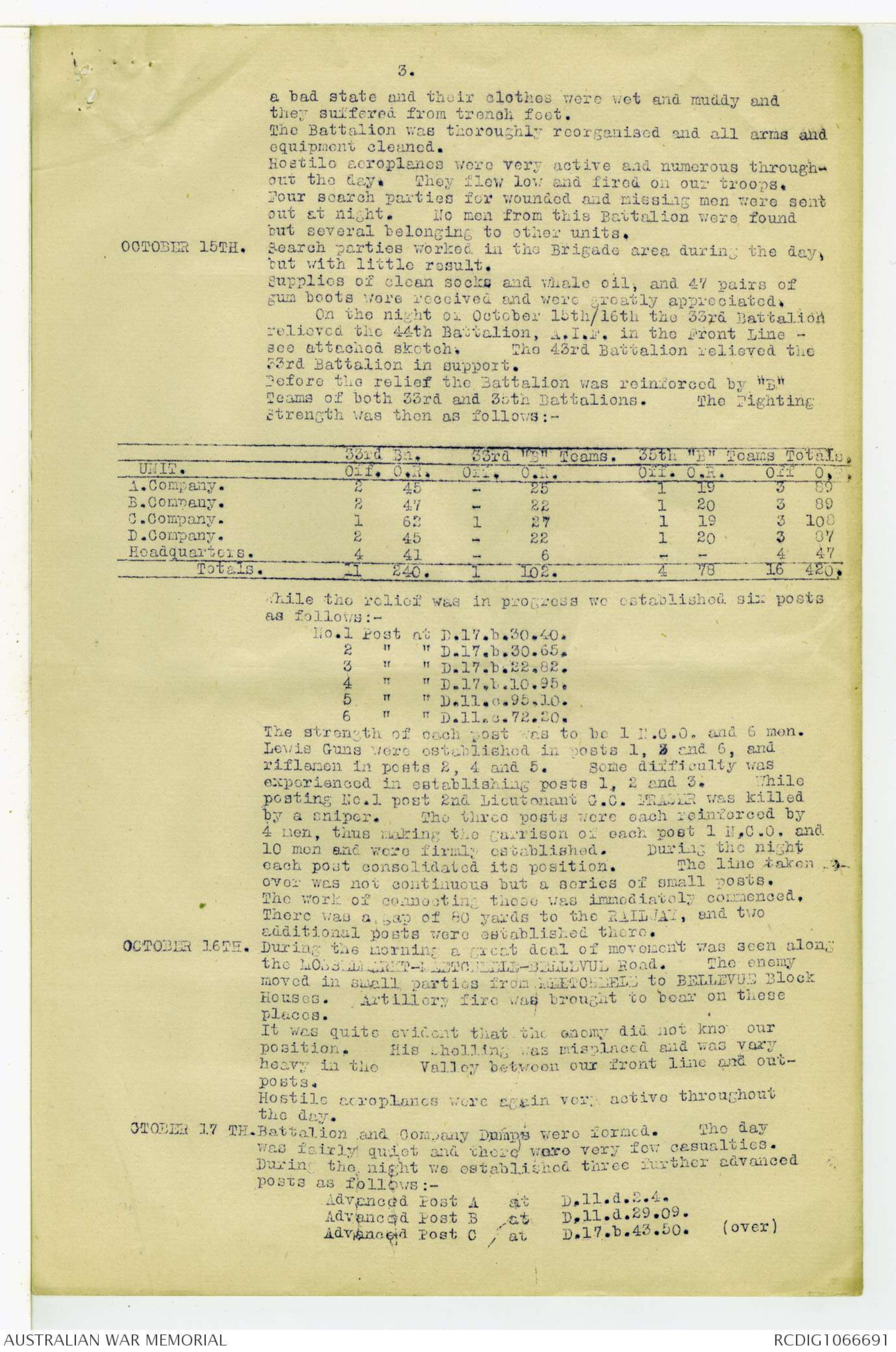
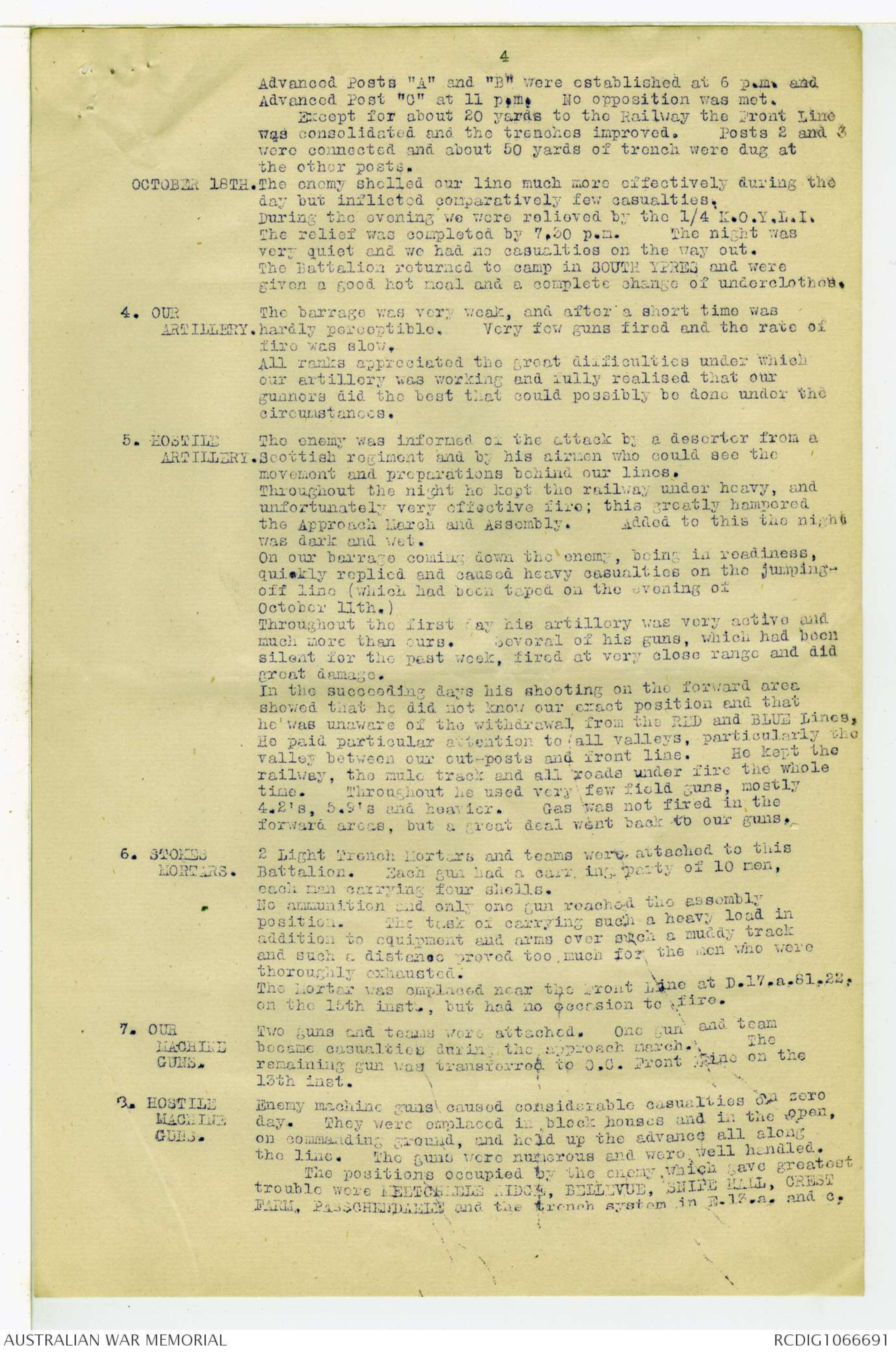

Post Office
Townsville.
Queensland
29th Dec' 29.
Mr. C.N. Bean.
Dear Sir,
Have read with absorbing interest
your Volume of the "A.I.F. in France" x being an
ex-digger of the 7th Infantry Brigade. I devoured
every line relating to the exploits of the Blue
Diamonds at Flers, Pozieres x [[?Ceuquet]] Farm.
Am attaching an addendum of one exploit
in the heavy fighting in the Ypres salient of
of Sept & October 1917, which you may use at
your own discretion, in your next Volume
of the '17 stunts. Capt. J. Herbert of A. Coy. 26th
Battn (killed at Dernancourt in April 1918)
may have reported on the following to B H.Q.
in the history of the 26th if there is one - but
I can vouch for its authenticity for I was "knocked"
on Oct 4th while a member of the machine
gun teams referred to.
With the compliments of the Season. x for many of them.
Sincerely
G. Prideaup.
[["?]] When passing through the 25th Battn at
Zonnebeke on the morning of Oct. 4 to their
final objective on the slope of Passchendaele
Ridge, the Lewis gunners of A.Coy 26th were
held up in Zonnebeke cemetery & suffered
severely, that gallant & courteous officer
Lt. MacDonald being sniped- and killed-there.
Of a complement of ten men [[eager?]] C/ [[Comp?]].
Backie & Pte Peak were the only survivors
of their respective Lewis gun teams to bring
their guns out."
Backie came from Ingham [[ ?]] & Peak, I
think, from the [[Towers?]] goldfield. [[?]]
Note
Gen. Rosenthal's diary
is in Mitchell Library
[[ 18Coby?]]
Ypres 1917- 3rd Aust Division
From Lt Col. G.T. Wieck
[*1917*] Ypres, 3rd Division. After Jess went to 3rd Division all the visiting
of the front line fell upon Wieck ( so far as the general staff of
commander were concerned. Monash himself rarely got behind the xxxxxxx brigade headquarters-a fact which was well known to his
men and detrimental to his leadership.)
On October 18th, after the failure of the attack on Passchendaele,
W. was sent by Monash up to the front to see whether the
brigadiers had, any of them, lost their nerve. It seemed to Monash
from some indications that they had. W. went to Rosenthal and Cannan
and found they were perfectly right. After great difficulty,
being lost for two hours on the way, he happened straight upon McNicoll's
headquarters, and found that Mc.N. had "dropped his bundle." He
was saying that there was not more than 40 men left in his brigade,
and was clearly unaware of the situation.
Wieck does not believe that the New Zealanders would have been
stopped by any wire they were likely to meet on that battlefield. He
thinks they were late on their jumping off line, and so lost
their barrage. This however is not founded on much more than conjecture.
On the other hand the staff of the 66th Division, who came into
the 3rd Division Hqrs after October 4th, he says, were plainly incapable,
and their commander Lawrence did not seem to have any control
over them. (In this he is amply borne out).
SECRET.
THIRD AUSTRALIAN DIVISION.
Divisional Headquarters,
11th. October, 1917.
S.G. 400/13/30. (see image of stamp)
YPRES BATTLE GENERAL STAFF CIRCULAR No. 30.
The following is TIME TABLE of Operations for
12th. October, 1917. -
Time. Operation.
a.m.
5.25 Artillery Barrage opens.
5.31 Machine Gun Barrage opens.
5.41 HEINE HOUSE and HILLSIDE FARM captured.
6.37 RED LINE (First Objective) captured.
7.55 Contact Plane calls for flares.
8.25 Barrage advance resumes.
9.21 BLUE LINE (Second Objective) captured.
9.55 Contact Plane calls for flares.
10.25 Barrage advance resumes.
10.41 PASSLE Church reached.
11.05 Dugouts on Railway captured.
11.29 GREEN Dotted Line (Third Objective) captured.
11.55 Barrage advance resumes.
p.m.
12.11 Final Objective (GREEN LINE) reached.
12.25 Contact Plane calls for flares.
ACKNOWLEDGE
G.H. [[Jameson?]]
Lieut-Colonel. -
General Staff.
DISTRIBUTION.
G.O.C.
"G" Staff.
"A.Q" Staff.
C.R.A.
C.R.E.
3rd. Aust. Div. Sig. Coy.
9th. A. I. Bde.
10th. do.
11th. do.
3rd. Aust. Pion. Bn.
A.D.M.S.
D.M.G.O
21st. Squadron, R.F.C.
2nd. ANZAC "G" (For inf
4th. Aust. Div. "
N.Z. Division. "
War Diary.
File.
Lt. Col [[G.H/?]] [[Mach?]] [[Aug?]] [[DSO?]]
33RD BATTALION. A.I.F.
REPORT ON PHASE V. THIRD BATTLE OF YPRES.
Period: October 11th/ 12th to October 18th/19th
Reference Maps: BELGIUM and part of FRANCE, Sheet 28, Ed.3, 1/40,000.
ZONNEBEKE 28 N. [[E?]] .1. Ed. 7A. 1/10,000.
PASSCHENDAELE (Parts of Sheet 20 & 28 ) 1/10,000.
1. APPROACH The Battalion left CAVALRY FARM (I.10.a.05.55 ) at 10 p.m.
MARCH. on October 11th/12th and proceeded via "J" Track and the
YPRES-ROULERS RAILWAY to the position of Assembly. "J"
Track, as far as the RAILWAY, was policed under Battalion
arrangements. For the most part this track to the
Railway Line was fair and except for encountering a pack
mule train returning by this route good progress was made
and the Battalion kept intact. ZONNEBEKE RAILWAY
STATION was reached at 1.20 a.m. and here we were delayed
by the 36th Battalion. The last 1500 yards to the
Assembly position took four hours. The track along the
railway was very poor and very narrow, there being just
sufficient room for single file. The whole of the
Brigade and 47th and 48th Battalions who were
being relieved used this route consequently there was
considerable congestion and delays.
The enemy shelled the railway line very heavily and
caused considerable casualties to all Units. "D"
Company lost practically the whole of one platoon during
the march and altogether lost 20 other ranks; "B"
Company lost 4 other ranks and "A" Company 5 other ranks.
"C" Company had no casualties.
2. ASSEMBLY. The Battalion was to assemble 100 yards West of and
parallel with DAB TRENCH in D.16.b., but the 36th
Battalion was there, [[we?]] therefore assembled 50 yards
West of the SEINE-BEECHAM ROAD in D.16.d. The
assembly was complete at 5.21 a.m.
3. THE BATTLE. On the opening of the barrage "D" Company moved forward
without orders from Battalion Headquarters. Lieut.
I.C. DIGHT, O.C., "D" Company became a casualty while
reconnoitring on the evening of October 11th and Lieut.
W. McLEAN, M.C. was given command: he ordered the Company
forward and assisted the assaulting Battalions. They
assisted in the capture of the RED LINE and a few got as
far as the BLUE LINE. Sergeant W.A. [[McLean?]] with seven
men captured two Block Houses and took 30 prisoners in
one, and 40 prisoners in the other.
The Company suffered heavy casualties including three
officers. On finding that the Battalion had not come
forward the H.C.O's. reorganised and returned to
Battalion Headquarters at 10 a.m.
At 9 a.m. Company Commanders reported to Battalion
Headquarters and recieved orders to be ready to proceed
to take up position in depth from D. 11. d. 30. 80 to
D. 11. d. 50. 25. "B" Company and the remnants of "D"
Company were formed into a composite company known as
[["B"?]] Company under Lieut. O.R. CORMACK. Up to this time
three Company Commanders had become casualites. On
receipt of orders from Brigade, instructions were given
at 10.22 a.m. to companies to proceed to D. 11. d.
"A" Company ( Captain W.F. HINTON) moved forward to the
correct position, but "B" Company moved north of
AUGUCTUS WOOD, and were followed by "C" Company (2nd Lieut.
A.G. KILPATRICK). Both "B" and "C" Companies suffered
heavily form shell fire and from machine guns at BELLEVUE
and [[CREST?]] FARM.
A Battalion Forward Command Post was established at
D. 11. c. 4. 0 and at 12.45 p.m. the [[R.M.O.?]] was ordered to
prepare to move his [[R.?.F.?]] to D. 17. [[c?]]. 39. 55 at 2 p.m.
(over)
- 2
At 2.40 p.m. "B" and "C" Companies were instructed to
move forward to D. 11. d. but owing to the heavy fire
being brought on them it was impossible for them to move there. At 1.41 p.m. and 2.13 p.m I received word that
the Brigade on our right had fallen back. Later the
9th Brigade withdrew, and "A" Company which had lost
heavily, including Captain HINTON, finding themselves
ahead of our new line withdrew. Meantime, "B" and "C"
Companies consolidated on a line near the jumping off
line in conjunction with the 10th Brigade.
Being in Divisional reserve and held in readiness to
pocket PASSCHENDAELE and capture the GREEN DOTTED LINE
and then the GREEN LINE, in the event of the 10th Brigade
failing to capture PASSCHENDAELE, I was given the strictest
instructions not to move without direct orders from Brigade
Headquarters, no matter what the situation was. These
orders were mmost emphatic. All four Battalion Headquarters
being in the same dug-out, I therefore knew exactly
what the situation was but was unable to give assistance.
It was unfortunate that we were not in telephone communication
with Brigade Headquarters.
At about 3.30 p.m. Captain B.E. TOLLEY, Assistant Brigade
Major, came to Battalion Headquarters with orders that at
4.30 p.m. with artillery support the 33rd Battalion was to
side-slip morthwards to the 10th Brigade's assistance and
capture PASSCHENDAELE. Meantime the 9th Brigade and
withdrawn and thes operation cancelled.
The 33rd Battalion was later placed in Brigade Reserve.
During the morning of October 13th, the 34th, 35th and 36th
Battalions reorganised on the new line, and on completion,
I was ordered to move to a support position. Lieut-Colonel
MILNE, D.S.O., O.C., FRONT LINE reported the reorganisation
complete at 8.58 a.m. the 33rd Battalion then moved to
a position in D. 16. b. The eastern boundary was a line 50
yards West of and parallel with the HAMBOURG-[[NIEUEMHOLEN?]] Road,
the Southern boundary the road running from D. 16. b. 68. 10 to
D. 16. d. 15. 65, and the Northern boundary the HAMBOURG-BEECHAM
Road, Companies were organised in depth to 100 yards.
These dispositions were completed by 11 a.m. The
Battalion dug in and got under cover.
At 10 a.m. the fighting strength of the Battalion was as
follows:-
A. Company. Officers. 1 Other ranks. 30.
B. Company. Officers. 2 Other ranks. 42.
C. Company. Officers. 2 Other ranks. 86.
D. Company. Officers. 2 x Other ranks 24.
Total. Officers. 7 Other ranks. 182.
Battalion H.Q. Officers. 4 Other ranks. 49.
Grand Total. Officers. 11 Other ranks. 231
x 2nd Lieut. L.R. BELL, Liason Officer to the 36th Battalion,
reported back on the night of October 12th/ 13th and
rejoined "D" Company.
While in this support position we had only two casualties.
On the night of October 13th/ 14th the Brigade was relieved
by the 11th Australian Infantry Brigade. The 33rd Battalion
was relieved by the 43 rd Battalion and moved to
another support position in D. 16. c. and d, 100 yards south
West of and parallel to the [[SEUNE?]] - BEECHAM Road. The men
again dug themselves in. During the night two parties
under officers searched the area over which we had worked and
brought in many wounded of all units.
OCTOBER 14TH. Hostile shelling throughout the day was lighter than on the
two previous days, and we had very few casualties. In the
afternoon and evening we drew 37 shelters from near the
ZONNEBEKE RAILWAY STATION and the men were made tolerably
comfortable. Owing to the rain and mud the men were in
-
3
a bad state and their clothes were wet and muddy and
they suffered from trench feet.
The Battalion was thoroughly reorganised and all arms and
equipment cleaned.
Hostile aeroplanes were very active and numerous throughout
the day. They flew low and fired on our troops.
Four search parties for the wounded and missing men were sent
out at night. No men from this Battalion were found
but several belonging to other units.
OCTOBER 15TH Search parties worked in the Brigade area during the day,
but with little result.
Supplies of clean socks and whale oil, and 47 pairs of
gum boots were received and were greatlt appreciated.
On the night of October 15th/ 16th the 33rd Battalion
relieved the 44th Battalion, A.I.F in the Front Line-
see attached sketch. (The sketch is missing from the papers.) The 43rd Battalion relieved the
33rd Battalion in support.
Before the relief the Battalion was reinforced by "B"
Teams of both 33rd and 35th Battalions. The Fighting
Strength was then as follows:-
33rd Bn.
A. Company. Off: 2 O.R: 45
B. Company. Off: 2 O.R: 47
C. Company. Off: 1 O.R: 62
D. Company. Off: 2 O.R: 45
Headquarters. Off: 4 O.R: 41
Totals. Off: 11 O.R: 240
33rd "B" Teams.
A. Company. Off: - O.R: 25
B. Company. Off: - O.R: 22
C. Company. Off: 1 O.R: 27
D. Company. Off: - O.R: 22
Headquarters. Off: - O.R: 6
Totals. Off: 1 O.R: 102
35th "B" Teams.
A. Company. Off: 1 O.R: 19
B. Company. Off: 1 O.R: 20
C. Company. Off: 1 O.R: 19
D. Company. Off: 1 O.R: 20
Headquarters. Off: - O.R: -
Totals.
Off: 4 O.R: 78
Totals.
Off: 16 O.R: 420
While the relief was in progress we established six posts
as follows:-
No. 1 Post at D. 17. b. 30. 40.
2 " " D. 17. b. 30. 65.
3 " " D. 17. b. 22. 82.
4 " " D. 17. b. 10. 95.
5 " " D. 11. c. 95. 10.
6 " " D. 11. c. 72. 20.
The strength of eaach post was to be 1 N.C.O. and 6 men.
Lewis Guns were established in posts 1, 3 and 6, and
riflemen in posts 2,4 and 5. Some difficulty was
experienced in establishing posts 1,2 and 3. While
posting No.1 post 2nd Lieutenant G.C FRASER was killed
by a sniper. The three posts were each reinforced by
4 men, thus making the garrison of each post 1 N.C.O. and
and 10 men and were firmly established. During the night
each post consolidated its position. the line taken
over was not continuous but a series of small posts.
The work of connecting these was immediately commenced.
There was a gap of 80 yards to the RAILWAY, and two
additional posts were established there.
OCTOBER 16TH. During the morning a great deal of movement was seen along
the [[?-?]]- BELLEVUE Road. The enemy
moved in small parties from [[?]] to BELLEVUE Block
Houses. Artillery fire was brought to bear on these
places.
It was quite evident that the enemy did not know our
position. His shelling was misplaced and was very
heavy in the Valley between our front line and outposts.
Hostile aeroplanes were again very active throughout
the day.
OCTOBER 17TH. Battalion and Company Dumps were formed. The day
was fairly quiet and there were very few casualties.
During the night we established three further advanced
posts as follows:-
Advanced Post A at D. 11. d. 2. 4.
Advanced Post B at D. 11. d. 29. 09.
Advanced Post C at D. 17. b. 43. 50. (over)
4
Advanced Posts "A" and "B" were established at 6 p.m. and
Advanced Post "C" at 11 p.m. No opposition was met.
Except for about 20 yards to the Railway the Front Line
was consolidated and the trenches improved. Posts 2 and 3
were connected and 50 yards of trench were dug at
the other posts.
OCTOBER 18TH The enemy shelled our line much more effectively during the
day but inflicted comparatively few casualties.During the evening we were relieved by the 1/4 K.O.Y.L.I.
The relief was completed by 7.30 p.m. The night was
very quiet and we had no casualties on the way out.
The Battalion returned to camp in SOUTH YPRES and were
given a good hot meal and a complete change of underclothes.
4. OUR The barrage was very weak, and after a short time was
ARTILLERY hardly perceptible. Very few guns fired and the rate of
fire was slow.
All ranks appreciated the great difficulties under which
our artillery was working and fully realised that our
gunners did the best that could possibly be done under the
circumstances.
5. HOSTILE The enemy was informed of the attack by a deserter from a
ARTILLERY Scottish regiment and by his airmen who could see the
movement and preparations behind our lines.
Throughout the night he kept the railway under heavy, and
unfortunately very effective fire; this greatly hampered
the Approach March and Assembly. Added to this the night
was dark and wet.
On our barrage coming down the enemy, being in readiness,
quickly replied and caused heavy casualties on the jumping off
line (which had been taped on the evening of
October 11th.)
Throughout the first day his artillery was very active andmuch more than ours. Several of his guns, which had been
silent for the past week, fired at very close range and did
great damage.
In the succeeding days his shooting on the forward area
showed that he did not know our exact position and that
he was unaware of the withdrawal from the RED and BLUE Lines,
He paid particular attention to all valleys, particularly the
valley between our cut-posts and front line. He kept the
railway, the mule track and all roads under fire the whole
time. Throughout he used very few field guns, mostly
4.2's, 5.9's and heavier. Gas was not fired in the
forward areas, but a great deal went back to our guns.
6. STOKES 2 Light Trench Mortars and teams were attached to this
MORTARS. Battalion. Each gun had a carrying party of 10 men,
each man carrying four shells.
No ammunition and only one gun reached the assembly
position. The task of carrying such a heavy load in
addition to equipment and arms over such a muddy track
and such a distance proved too much for the men who were
thoroughly exhausted.
The Mortar was [[omplaned?]] near the Front Line at D. 17. a. 81. 22.
on the 15th inst., but had no occasion to fire.
7. OUR Two guns and teams were attached. One gun and team
MACHINE became casualties during the approach march. The
GUNS. remaining gun was transferred to O.C Front Line on the
13th inst.
8. HOSTILE Enemy machine guns caused considerable casualites on zero
MACHINE day. They were emplaced in block houses and in the open,
GUNS. on commanding ground, and held up the advance all along
the line. The guns were numerous and were well handled.
The positions occupied by the enemy, which gave greatest
trouble were [[ MEETCHABLE?]] RIDGE, BELLEVUE, SNIPE HALL, CREST
FARM, PASSCHENDAELE and the trench system in E. 13. a. and c.
5.
9. COMMUNICATIONS Battalion headquarters were established at SEINE, at
D. 16. d. 51. 47. Communications with Brigade Headquarters,
which were at D. 26. b. 27. 42 was by means of(i) Visual (ii) Runner and (iii) Pigeons, and with
Companies by (i) Runner (ii) Visual.
34th Battalion and 35th Battalion Headquarters were
also established at SEINE at zero, and the 36th
Battalion after the withdrawal established their
Headquarters in the same dug-out. Considerable
inconvenience was thus caused by having four Battalion
Headquarters in the one dug-out which measured
12' x 8' x 6'. The 33rd Battalion practically did
the whole of the signal work.
In the afternoon of October 12th a telephone line was
laid from Brigade. It ran along the railway and
was soon badly damaged. It was never right through
and for a short time messages were wired to the
furthest linesman relay post and thence sent by runner
to Brigade. That night the line was abandoned.
At noon on zero day the Signals Officer, Lieut. C.A.K.
COHEN proceeded to HEINE HOUSE with 1 N.C.O.,
2 signallers, 2 linesmen, 1 pigeoneer, and 4 runners
and the necessary equipment to establish a forward
command post. A suitable location was found at
D. 11.c. 4. 0 and the advanced headquarters established.
A line was run to HAMBURG and from there an excellent
visual could be obtained to SEINE and HILL 40.
This position too was close to the proposed Brigade
Forward Station. Owing to the withdrawal of the
34th, 35th and 36th Battalions behind this block house.
Lieut. COHEN reported back to Battalion Headquarters.
Visual to Brigade worked fairly well.
On the night of October 15th/16th when the Battalion
moved to the Front Line, a forward Station manned by
3 signallers and 3 runners was established in a blockhouse
at D. 15. b. 72. 20. "A" and "B" Company Headquarterswere in a a blockhouse at D. 16. .b. 90. 65. "C"
and "D" in a blockhouse at D. 17. a. 33. 20.
Direct visual with the Companies was maintained and a line
communication from the Forward Relay Post.
Owing to the marshy country and heavy shelling it was
exceedingly difficult to maintain the lines, and it was
just as much as the section could do to maintain the
two lines.
After zero day the Linesman Relay and Runner Relay
Posts from Brigade to Battalion were abandoned.
This added considerably to the work of the Battalion
runners and delayed messages.
During the period we were forward, 200 messages passed
through our signals.
The runners had a most difficult and exhausting work.
The ground was almost impassable and the nights were
very dark. Of the 22 runners attached to Battalion
Headquarters 11 were casualties. Companies lost
over 50% of their runners. All did splendid work.
Lucas Lamps worked very well although they were
in a muddy state. Men were bogged up to their
armpits. The phones were not in good order owing
the mud and wet.
Pigeons were not made much use of - the supply was
insufficient.
The Battalion captured
70 prisoners.
2 Machine guns.
2 Minenwerfers.
1 Grenatenwerfer.
1 Searchlight.
(over)
 Sam scott
Sam scottThis transcription item is now locked to you for editing. To release the lock either Save your changes or Cancel.
This lock will be automatically released after 60 minutes of inactivity.